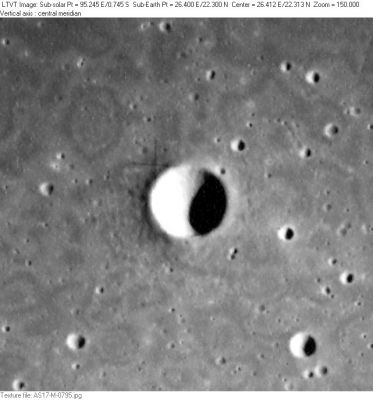Difference between revisions of "Borel"
| Line 7: | Line 7: | ||
|} | |} | ||
<div id="toc"> | <div id="toc"> | ||
| − | + | [http://www.lpod.org/coppermine/albums/userpics/Borel_AS17-M-0795_LTVT.JPG [[Image:normal_Borel_AS17-M-0795_LTVT.JPG|external image normal_Borel_AS17-M-0795_LTVT.JPG]]]<br /> ''[http://lpod.org/coppermine/displayimage.php?pos=-2467 AS17-M-0795]'' Regarding the background mottles: a similar pattern appears on all the Apollo 17 Metric images of this region, but the details of the reticulation are different on every frame. The pattern is listed as a photographic defect on [http://www.lpi.usra.edu/resources/mapcatalog/LTO/lto42c2_1/ LTO-42C2] (see annotation in lower right corner).<br /> <br /> | |
| − | |||
==Images== | ==Images== | ||
[http://www.lpod.org/coppermine/thumbnails.php?album=search&type=full&search=Borel LPOD Photo Gallery] [http://www.lpi.usra.edu/resources/lunar_orbiter/bin/srch_nam.shtml?Borel%7C0 Lunar Orbiter Images] [http://www.lpi.usra.edu/resources/apollo/search/feature/?feature=Le%20Monnier%20C Apollo Images]<br /> - The bowl-shaped crater '''Borel''' was also captured on Apollo 15's orbital ''ITEK''-panoramic frame [http://www.lpi.usra.edu/resources/apollo/frame/?AS15-P-9304 AS15-P-9304] and its stereo-companion [http://www.lpi.usra.edu/resources/apollo/frame/?AS15-P-9309 9309]. '''Borel''' is the largest one of the depicted craters.<br /> - Post sunrise views of '''Borel''' were captured on Apollo 17's ''ITEK'' frames [http://www.lpi.usra.edu/resources/apollo/frame/?AS17-P-2319 AS17-P-2319] and [http://www.lpi.usra.edu/resources/apollo/frame/?AS17-P-2326 AS17-P-2326]. On both frames, scroll to the right until you see the largest one of the small craters: that's '''Borel'''.<br /> Additional research orbital Apollo 15 and Apollo 17 photography: Danny Caes<br /> <br /> | [http://www.lpod.org/coppermine/thumbnails.php?album=search&type=full&search=Borel LPOD Photo Gallery] [http://www.lpi.usra.edu/resources/lunar_orbiter/bin/srch_nam.shtml?Borel%7C0 Lunar Orbiter Images] [http://www.lpi.usra.edu/resources/apollo/search/feature/?feature=Le%20Monnier%20C Apollo Images]<br /> - The bowl-shaped crater '''Borel''' was also captured on Apollo 15's orbital ''ITEK''-panoramic frame [http://www.lpi.usra.edu/resources/apollo/frame/?AS15-P-9304 AS15-P-9304] and its stereo-companion [http://www.lpi.usra.edu/resources/apollo/frame/?AS15-P-9309 9309]. '''Borel''' is the largest one of the depicted craters.<br /> - Post sunrise views of '''Borel''' were captured on Apollo 17's ''ITEK'' frames [http://www.lpi.usra.edu/resources/apollo/frame/?AS17-P-2319 AS17-P-2319] and [http://www.lpi.usra.edu/resources/apollo/frame/?AS17-P-2326 AS17-P-2326]. On both frames, scroll to the right until you see the largest one of the small craters: that's '''Borel'''.<br /> Additional research orbital Apollo 15 and Apollo 17 photography: Danny Caes<br /> <br /> | ||
| Line 22: | Line 21: | ||
* Viscardy, 1985: 0.95 km | * Viscardy, 1985: 0.95 km | ||
| − | * The shadow in AS17-M-0795 suggests a bowl-shaped form with a maximum depth of about 1060 m. <span class="membersnap">- | + | * The shadow in AS17-M-0795 suggests a bowl-shaped form with a maximum depth of about 1060 m. <span class="membersnap">- Jim Mosher</span> |
| − | * The WAC mosaic in the online LROC ACT-REACT QUICK MAP shows some sort of dark concentric band just below '''Borel''''s rim (all the way around on its inner slopes). <span class="membersnap">- | + | * The WAC mosaic in the online LROC ACT-REACT QUICK MAP shows some sort of dark concentric band just below '''Borel''''s rim (all the way around on its inner slopes). <span class="membersnap">- DannyCaes <small>Aug 20, 2017</small></span> |
<br /> | <br /> | ||
==Nomenclature== | ==Nomenclature== | ||
Félix Édouard Émile; French mathematician (1871-1956).<br /> | Félix Édouard Émile; French mathematician (1871-1956).<br /> | ||
| − | * This replacement name for a formerly [http://the-moon.us/wiki/lettered%20crater lettered crater] was introduced on [http://www.lpi.usra.edu/resources/mapcatalog/LTO/lto42c2_1/ LTO-42C2]. <span class="membersnap">- | + | * This replacement name for a formerly [http://the-moon.us/wiki/lettered%20crater lettered crater] was introduced on [http://www.lpi.usra.edu/resources/mapcatalog/LTO/lto42c2_1/ LTO-42C2]. <span class="membersnap">- Jim Mosher</span> |
<br /> | <br /> | ||
==LPOD Articles== | ==LPOD Articles== | ||
| Line 35: | Line 34: | ||
<br /> <br /> | <br /> <br /> | ||
---- | ---- | ||
| − | + | </div> | |
Revision as of 16:15, 15 April 2018
Contents
Borel (in the southeastern part of Mare Serenitatis)
(formerly Le Monnier C)
|
Lat: 22.3°N, Long: 26.4°E, Diam: 4 km, Depth: 1.09 km, Rükl: 24 |
AS17-M-0795 Regarding the background mottles: a similar pattern appears on all the Apollo 17 Metric images of this region, but the details of the reticulation are different on every frame. The pattern is listed as a photographic defect on LTO-42C2 (see annotation in lower right corner).
Images
LPOD Photo Gallery Lunar Orbiter Images Apollo Images
- The bowl-shaped crater Borel was also captured on Apollo 15's orbital ITEK-panoramic frame AS15-P-9304 and its stereo-companion 9309. Borel is the largest one of the depicted craters.
- Post sunrise views of Borel were captured on Apollo 17's ITEK frames AS17-P-2319 and AS17-P-2326. On both frames, scroll to the right until you see the largest one of the small craters: that's Borel.
Additional research orbital Apollo 15 and Apollo 17 photography: Danny Caes
Maps
(LAC zone 42C2) LAC map Geologic map LM map LTO map
Description
Description: Wikipedia
Additional Information
Depth data from Kurt Fisher database
- Westfall, 2000: 1.09 km
- Viscardy, 1985: 0.95 km
- The shadow in AS17-M-0795 suggests a bowl-shaped form with a maximum depth of about 1060 m. - Jim Mosher
- The WAC mosaic in the online LROC ACT-REACT QUICK MAP shows some sort of dark concentric band just below Borel's rim (all the way around on its inner slopes). - DannyCaes Aug 20, 2017
Nomenclature
Félix Édouard Émile; French mathematician (1871-1956).
- This replacement name for a formerly lettered crater was introduced on LTO-42C2. - Jim Mosher
LPOD Articles
Bibliography
